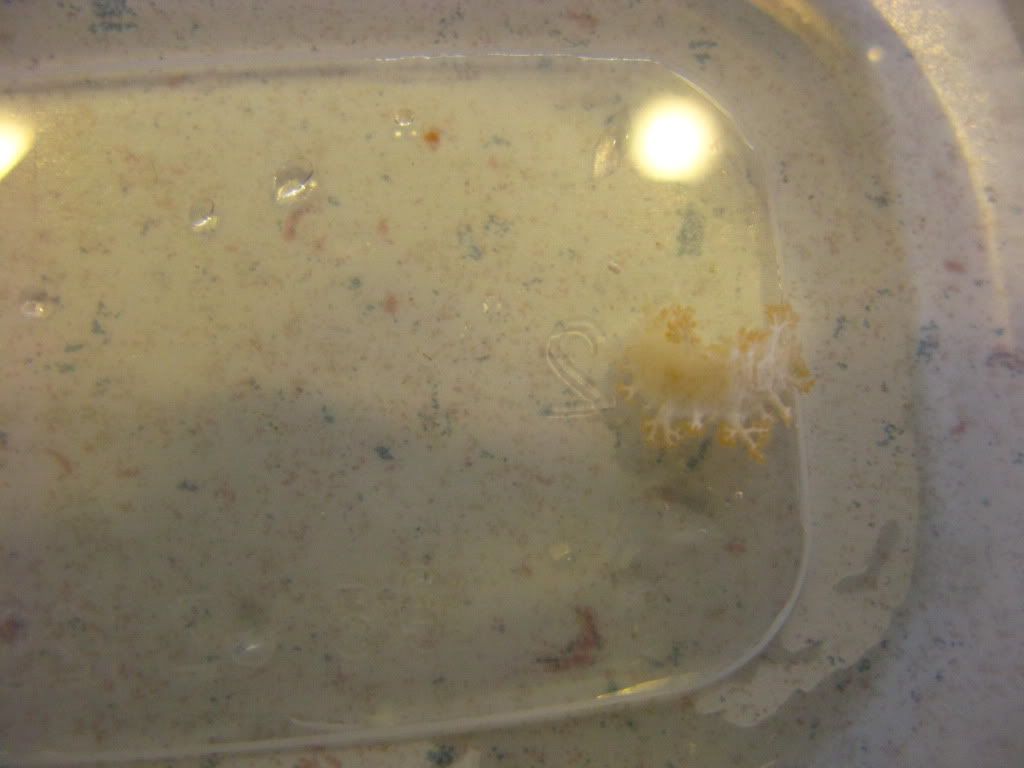Good or Bad?
- Thread starter bender77
- Start date
spanko
Active Member
Bad. Soft coral eating nudibranch me thinks. Check the leather coral, use magnifying glass, for more and anything that looks like egg clusters. Remove all.
From pet eductaion;
"Identification: Soft Coral-eating NudibranchSeveral species of nudibranch which feed upon Soft Corals like Sarcophyton sp. Leather corals, Xenia sp., Zoanthus sp., and Palythoa sp. polyps have made their way into the industry over the years. Most of the soft-coral-eating-nudibranchs can reach a size of 2 cm when full grown, and are best seen after the lights have been off on the aquarium for several hours. They often mimic the appearance of the coral they are preying upon, making them difficult to spot. Soft coral eating nudibranchs will slowly consume these corals causing bare spots or discoloration on some or all of the corals tissue.
Symptoms and signs: Corals that become infected with these pests will begin to show white spots where the nudibranchs have eaten away the tissue of the coral. The most vulnerable seem to be Montipora capricornis, also known as vase corals, as well as Montipora digitata, the branching form. Many times the nudibranch will begin feeding on the underside of the coral, and it will not become apparent to the hobbyist that the coral is being damaged until it can be seen in plain view on the top of the colony.
Treatment: Controlling outbreaks of these pests is difficult, and several different techniques are being experimented with. Removal of these pest is often performed manually with tweezers.
*
Auriga ButterflyfishNatural predators of the nudibranch are butterflyfish of the Chaetodon genus, wrasse of the genus Thalassoma and Coris. Two species of Butterflyfish fish in particular that have been noted as being efficient predators are: Chaetodon semilarvatus, the Red Sea Butterfly and Chaetodon auriga, the Thread Fin Butterfly. Be advised that these fish will also consume worms, such as feather dusters and those that inhabit live sand beds in the reef aquarium.
*
Lugol's SolutionChemical techniques have been used also, yielding varying results. Iodine dips using a concentrated Lugol's and aquarium water mixture will kill the nudibranch, but seems to have a limited success rate on the eggs. Another chemical called Levamisol has been used with a good deal of success."
From pet eductaion;
"Identification: Soft Coral-eating NudibranchSeveral species of nudibranch which feed upon Soft Corals like Sarcophyton sp. Leather corals, Xenia sp., Zoanthus sp., and Palythoa sp. polyps have made their way into the industry over the years. Most of the soft-coral-eating-nudibranchs can reach a size of 2 cm when full grown, and are best seen after the lights have been off on the aquarium for several hours. They often mimic the appearance of the coral they are preying upon, making them difficult to spot. Soft coral eating nudibranchs will slowly consume these corals causing bare spots or discoloration on some or all of the corals tissue.
Symptoms and signs: Corals that become infected with these pests will begin to show white spots where the nudibranchs have eaten away the tissue of the coral. The most vulnerable seem to be Montipora capricornis, also known as vase corals, as well as Montipora digitata, the branching form. Many times the nudibranch will begin feeding on the underside of the coral, and it will not become apparent to the hobbyist that the coral is being damaged until it can be seen in plain view on the top of the colony.
Treatment: Controlling outbreaks of these pests is difficult, and several different techniques are being experimented with. Removal of these pest is often performed manually with tweezers.
*
Auriga ButterflyfishNatural predators of the nudibranch are butterflyfish of the Chaetodon genus, wrasse of the genus Thalassoma and Coris. Two species of Butterflyfish fish in particular that have been noted as being efficient predators are: Chaetodon semilarvatus, the Red Sea Butterfly and Chaetodon auriga, the Thread Fin Butterfly. Be advised that these fish will also consume worms, such as feather dusters and those that inhabit live sand beds in the reef aquarium.
*
Lugol's SolutionChemical techniques have been used also, yielding varying results. Iodine dips using a concentrated Lugol's and aquarium water mixture will kill the nudibranch, but seems to have a limited success rate on the eggs. Another chemical called Levamisol has been used with a good deal of success."

